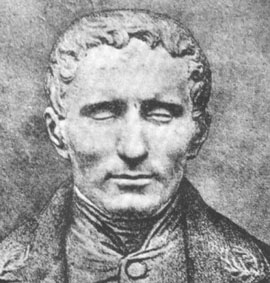| Louis Braille  Born: 4-Jan-1809 Born: 4-Jan-1809
Birthplace: Coupvray, France
Died: 6-Jan-1852
Location of death: Paris, France
Cause of death: Tuberculosis
Remains: Buried (see biographical note)
Gender: Male
Religion: Roman Catholic
Race or Ethnicity: White
Occupation: Inventor, Educator Nationality: France
Executive summary: Reading system for the blind Louis Braille was born in 1809 in the village of Coupvray, midway between the Brie and Champagne regions of France. As a two-year-old boy, playing with his father's stitching awl (a sharp-pointed tool used in making saddles), his hand slipped and the awl accidentally punctured his left eye. The wound soon became infected, blinding him first in that eye and, as the infection spread via the optic nerve, leaving him completely blind by the age of four or five. By all accounts he was a bright boy, and when he was about ten years old Braille received a scholarship to attend the Institut National des Jeunes Aveugles (National Institute for Blind Children) in Paris, the world's first school specifically for blind children.
In about 1821, when he was twelve years old, the school invited a former soldier named Charles Barbier to speak at the school, about a system of raised dots he had devised to allow soldiers to communicate silently, even in the dark. Little is known today of Barbier or his 12-dot system, except that his lecture ignited Braille's imagination. The boy began using a knitting needle to poke holes in paper, and in 1824 he introduced the rudiments of a six-dot reading and writing system that now bears his name, braille. In 1826 he began teaching at the Institute, and adapted his system for mathematics and music notation.
In 1829 the Institute published Braille's book explaining his system, titled Method of Writing Words, Music, and Plain Songs by Means of Dots, for Use by the Blind and Arranged for Them. In 1834 he made the last major modifications to braille, and from this point the system remains fundamentally the same today. In 1837 he completed the translation of a French history textbook. In 1839 he introduced Decapoint, a system of dot coding that can be written and read by either blind or sighted people. Word of Braille's language spread slowly among the sighted, and not a single newspaper in France published an obituary when he died in 1852. Over the next twenty years, however, braille swept the world and brought literacy to the blind in every language, in every civilized nation.
In 1952, marking the centennial of his death, the French government proposed relocating Braille's grave from his home town of Coupvray to The Pantheon in Paris, where many of France's greatest historical figures rest. Braille, however, had requested that he be buried in Coupvray, and the town's mayor was reluctant to let his body be taken away, so an odd compromise was struck. Helen Keller spoke at the memorial ceremony as most of Braille's earthly remains were entombed at The Pantheon, but his hands remain entombed at the Church Cemetery in Coupvray. Father: Simon-René Braille (harness and saddlemaker, b. 1765)
Mother: Monique Baron Braille (b. 1770, m. 1792)
Sister: Monique-Catherine Braille Caron (b. 1793)
Brother: Louis-Simon Braille (b. 1795)
Sister: Marie-Céline Braille Marniesse (b. 1797)
High School: Institut National des Jeunes Aveugles, Paris (1819-25)
Teacher: Institut National des Jeunes Aveugles, Paris (1826-52)
Exhumed from the Coupvray churchyard (20-Jun-1952)
Risk Factors: Blindness
Author of books:
Method of Writing Words, Music, and Plain Songs by Means of Dots, for Use by the Blind and Arranged for Them (1829)
A Brief History of France (1837)
Little Synopsis of Arithmetic for Beginners (1838)
Do you know something we don't?
Submit a correction or make a comment about this profile
Copyright ©2019 Soylent Communications
|